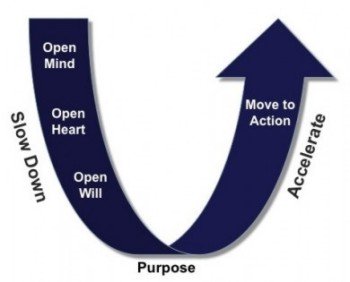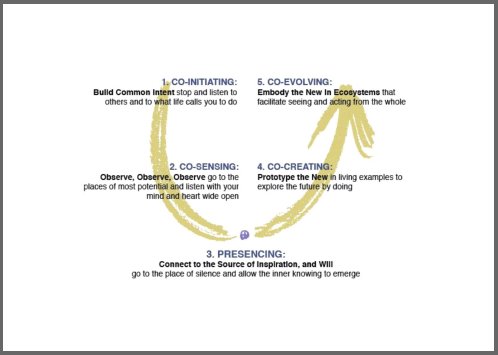|
Theory U - Leading from the future as it emergesHow to develop leadership capacities that would not otherwise be possible...
Introduction "Theory U - Leading from the future as it emerges" sounds a bit esoteric and "out there". I have thought long and hard about including this material partly because I have struggled with some of Otto Scharmer's concepts and the way he attempts to explain them, and partly because I am not sure how receptive visitors to this site will be to this material. However, I intuitively feel that what he has to say has direct relevance to strategies for managing change - and in particular to the creative process of leadership. Here are Otto Scharmer's ideas presented in his own language and taken from a 2 page summary available on his site.
I have added some personal observations and comments which are sited below the executive summary that follows.
Theory U - Executive SummaryIn his latest book "Theory U: Leading from the Future as It Emerges" (Cambridge, MA: Society for Organizational Learning, 2007), Otto Scharmer introduces readers to the theory and practice of the U process, based on a concept he calls “presencing.” This is a blend of the words “presence” and “sensing,” presencing signifies a heightened state of attention that allows individuals and groups to shift the inner place from which they function. When that shift happens, people begin to operate from a future space of possibility that they feel wants to emerge. Being able to facilitate that shift is, according to Scharmer, the essence of leadership today. At the end of the 17 page Executive Summary shown in the link further down this page you will find more complete coverage of how Theory U is being used by numerous stakeholders and corporate innovators, and information on how you might become involved with the Presencing Institute to which there is also a link below.
Using his experience working with some of the world’s most accomplished leaders and innovators, Otto Scharmer shows in Theory U how groups and organizations can develop seven leadership capacities in order to create a future that would not otherwise be possible. Tapping Our Collective Capacity We live in a time of massive institutional failure, collectively creating results that nobody wants. Climate change. AIDS. Hunger. Poverty. Violence. Terrorism. Destruction of communities, nature, life — the foundations of our social, economic, ecological, and spiritual well-being. This time calls for a new consciousness and a new collective leadership capacity to meet challenges in a more conscious, intentional, and strategic way. The development of such a capacity would allow us to create a future of greater possibilities. Illuminating the Blind Spot Why do our attempts to deal with the challenges of our time so often fail? Why are we stuck in so many quagmires today? The cause of our collective failure is that we are blind to the deeper dimension of leadership and transformational change. This “blind spot” exists not only in our collective leadership but also in our everyday social interactions. We are blind to the source dimension from which effective leadership and social action come into being. We know a great deal about what leaders do and how they do it. But we know very little about the inner place, the source from which they operate. And it is this source that “Theory U” attempts to explore. The U: One Process, Five Movements When leaders develop the capacity to come near to that source, they experience the future as if it were “wanting to be born”— an experience called “presencing.” That experience often carries with it ideas for meeting challenges and for bringing into being an otherwise impossible future. Theory U shows how that capacity for presencing can be developed. Presencing is a journey with five movements: (1) CO-INITIATING: Build Common Intent stop and listen to others and to what life calls you to do (2) CO-SENSING: Observe, Observe, Observe go to the places of most potential and listen with your mind and heart wide open (3) PRESENCING: Connect to the Source of Inspiration and Will, go to the place of silence and allow the inner knowing to emerge (4) CO-CREATING: Prototype the New in living examples to explore the future by doing (5) CO-EVOLVING: Embody the New in Ecosystems that facilitate seeing and acting from the whole
On that journey, at the bottom of the U, lies an inner gate that requires us to drop everything that isn’t essential. This process of letting-go (of our old ego and self) and letting-come (our highest future possibility: our Self) establishes a subtle connection to a deeper source of knowing. The essence of presencing is that these two selves— our current self and our best future Self — meet at the bottom of the U and begin to listen and resonate with each other. Once a group crosses this threshold, nothing remains the same. Individual members and the group as a whole begin to operate with a heightened level of energy and sense of future possibility. Often they then begin to function as an intentional vehicle for an emerging future.
Seven Theory U Leadership CapacitiesThe journey through the U develops seven essential leadership capacities. (1) Holding the space of listening The foundational capacity of the U is listening. Listening to others. Listening to oneself. And listening to what emerges from the collective. Effective listening requires the creation of open space in which others can contribute to the whole. (2) Observing The capacity to suspend the “voice of judgment” is key to moving from projection to true observation. (3) Sensing The preparation for the experience at the bottom of the U [presencing] requires the tuning of three instruments: the open mind, the open heart, and the open will. This opening process is not passive but an active “sensing” together as a group. While an open heart allows us to see a situation from the whole, the open will enables us to begin to act from the emerging whole. (4) Presencing The capacity to connect to the deepest source of self and will allows the future to emerge from the whole rather than from a smaller part or special interest group. (5) Crystallizing When a small group of key persons commits itself to the purpose and outcomes of a project, the power of their intention creates an energy field that attracts people, opportunities, and resources that make things happen. This core group functions as a vehicle for the whole to manifest. (6) Prototyping Moving down the left side of the U requires the group to open up and deal with the resistance of thought, emotion, and will; moving up the right side requires the integration of thinking, feeling, and will in the context of practical applications and learning by doing. (7) Performing A prominent violinist once said that he couldn’t simply play his violin in Chartres cathedral; he had to “play” the entire space, what he called the “macro violin,” in order to do justice to both the space and the music. Likewise, organizations need to perform at this macro level: they need to convene the right sets of players (frontline people who are connected through the same value chain) and to engage a social technology that allows a multi-stakeholder gathering to shift from debating to co-creating the new.
Theory U Encourages You to Step into the Emerging Future. Examples of these seven Theory U leadership capacities can be found in a number of multi-stakeholder innovations and corporate applications. The Presencing Institute is dedicated to developing these new social technologies by integrating science, consciousness, and profound social change methodologies.
See here for a 17 page Executive Summary of the Theory U book Check out: The Presencing Institute
Theory U - Personal observations...In my view, what Scharmer is talking about here with his Theory U is a more intuitive approach to leadership - and specifically in group leadership situations. There is nothing new in the idea of a creative thought and action process based around mental stillness, active listening, reflection, emergent intuitive ideas, and driving an initiative through an iterative process of successive prototypes. The world of IT has been doing this with the Rapid Application development [RAD] methodology for years. The appropriate balance of action/inaction has been familiar to practitioners of the Tao, Zen and many other meditation techniques for centuries. Some of the disciplines and processes he talks about will be alien to some - maybe many - business people and his "soft", qualitative, quasi-spiritual language is off-putting. But the fundamentals of what he proposes in Theory U are not new - as far as I can see. In my view, the originality may lie in applying this in a group context and a business environment. Taken from other perspectives it all makes sense. For example anyone involved in the creative arts will employ some or most of these processes. Neurologically this all about developing and using a "balanced brain" approach to leadership. By that I mean allowing more use of the right brain faculties of lateral, creative, and innovative thinking and less analysis, filtering and judgement.
From a scientific perspective we are into the realm of quantum physics and a perspective of a universe that is comprised of pure energy: that "solid" manifestations of matter "emerge" from the energy field of "infinite possibilities"; that thought [in whatever form] is energy and as such interacts, influences and responds to that energy field of infinite possibilities. As per the well known "observer effect" - where the act of observation influences the outcome of the experiment. Philosophically, we are into the realms of Buddhism in general, Zen in particular and especially the practise of "mindfulness" - or "present moment awareness". [For more on this see Eckhart Tolle - "The Power of Now"] To put Theory U into practise in a business context requires a leader who is comfortable with and capable of initiating this process, and a culture that is receptive to it.
# Use of language and terminology By the nature of the subject matter of Theory U it is hard to articulate this stuff without it sounding like some sort of religious or "belief based" experience. I wish Scharmer expressed himself more in the reductionist terminology of the neurology and physiology of his subject. So for example, if we examine the following paragraph copied from the Theory U summary above - I have highlighted what I regard as quasi spiritual phraseology that is not part of conventional business vocabulary: "On that journey, at the bottom of the U, lies an inner gate that requires us to drop everything that isn’t essential. This process of letting-go (of our old ego and self and letting-come (our highest future possibility: our Self) establishes a subtle connection to a deeper source of knowing." This is a business site specialising in the leadership and management of change in business and organisations, and these type or words are - at first sight - more suited to the Zen Buddhist meditation hall. For a Buddhist or anyone involved in any serious form of meditation practise - these are familiar concepts. My concern is that our scepticism and cynicism may cause us to "filter out" what he is trying to say in Theory U because this is unfamiliar territory to many us and unfamiliar language. Having got that off my chest I do have a strong intuitive sense that Theory U is actually deeply significant and relevant to the leadership of transformational change. # Consciousness and outcomes
If we substitute the words "focus and purpose" for the words "attention and intention" this becomes a more accessible idea. But do we really buy into the idea that a leader's "focus and purpose" [or thoughts and energy] really can change outcomes? Do we buy into the idea that "how we are" [i.e. the sum of all the inexpressible and intangible aspects of our make up as human being] actually affects events and outcomes in the "external" world? In my view: Theory U is about consciousness and how the level of consciousness we experience has a direct bearing on the quality and effectiveness of our leadership and management of change situations. # Listening - Observing - Sensing Scharmer's Theory U ideas about "Holding the space of listening" and "Observing" and "Sensing" make sense to me from the context of a meditation practise and it can be very powerful. But I have never used or experienced this in a group business context. Let me explain briefly how this works in meditation groups and see how it may be used in business.
Why this is powerful if that people speak far more intuitively and directly from a deeper or higher part of themselves and the quality of the contributions is generally far deeper and more insightful. Also, it leads to greater mutual respect and breaks down barriers and prejudices between people. So personally, I feel that this process could be applied to a business setting, and I assume that this is [or is similar to] the process that Scharmer is referring to in Theory U?
# Analysis /Thought vs Awareness /Creativity Or, to put it another way, if we look at this purely from a neurological and physiological level [i.e. the circuitry and "hardwiring" of our brains] then this is all about the interplay of thought and awareness - the interplay between left brain analysis and right brain creativity - and learning how to consciously navigate between these 2 states. As I said above, this is all very close to meditation practises and I know that in personal life, learning how to turn my brain off, stop thinking, judging, categorising etc is very calming and centring. I also know from experience that the more sessions I have when I slow down and do this stuff - then I get solutions, ideas and guidance, and far more easily and frequently. However, I don't fully understand how he sees groups doing this and applying Theory U - unless it along the lines of the deep listening process outlined above. As I have already said, I have absolutely no direct experience of trying any of this stuff in group situations in a business context as he suggests - though I would love to try it sometime as I sense it could be very powerful.
# Blindspots - sources of creation & innovation I can also identify with and support what he says about what Theory U refers to as "the blindspot" or the "source dimension" from which all great leadership, good ideas and innovations emerge. I feel that here he is talking about the creative process. All great ideas and innovations come from an "unknown" and "inexpressible " place - they just "come to us". I personally feel that there is proven wisdom in the old spiritual saying: "seek and ye shall find" - because I have to say that in my experience that is always the case. If I set a serious intention or purpose then move into mental stillness then the answers do emerge - especially if I uncouple my thinking mind and all the filters and past experiences and interpretations that it brings to bear on emerging ideas.
# Ideas emerge from stillness Also I find that ideas emerge as a "sense" or a [non-emotional] feeling - before they get translated into words and concepts. But again this is totally consistent with the neurological sequencing of the brain. In my experience, the 2 major difficulties with this are that (1) we have to really genuinely want to seek - a casual, flimsy enquiry will not work - there has to be serious emotional energy behind the question; and (2) we have to be still enough to be able to hear the answer. The old biblical verse "Be still and know that I am God" carries infinite more more truth than is immediately apparent.
# Prototyping I also love his Theory U concept of "prototyping" - taking an idea as it emerges and running with it in prototype form without subjecting it to deep thought and analysis. Then modifying it and shaping it to meet the stated requirements through a number of iterations. This is an integral part of how I work. This is not that dis-similar to the Rapid Application Development [RAD] used on certain large I.T. projects.
# A stroke of insight.... If you find this Theory U stuff hard work or you feel resistant to it - try coming back to it and reading it again later and maybe check out the links above to Scharmer's site and some of the reviews of his work. Also take a look at the section on this site on The Tao of Change and especially the section with Jill Bolte Taylor called "A stroke of insight" as this explains the physiological and neurological basis of what Scharmer is talking about.
Check out these additional and very practical resources on this site:Process theories of motivation - Personal needs drive behaviour Employee motivation techniques - How to achieve peak performance Open Space Technology - How to create inspired meetings How to give negative feedback - Without destroying the other person Toxic leadership - How to spot it and how to avoid it
Return to Inspirational Motivation Home Page Return to top
|











